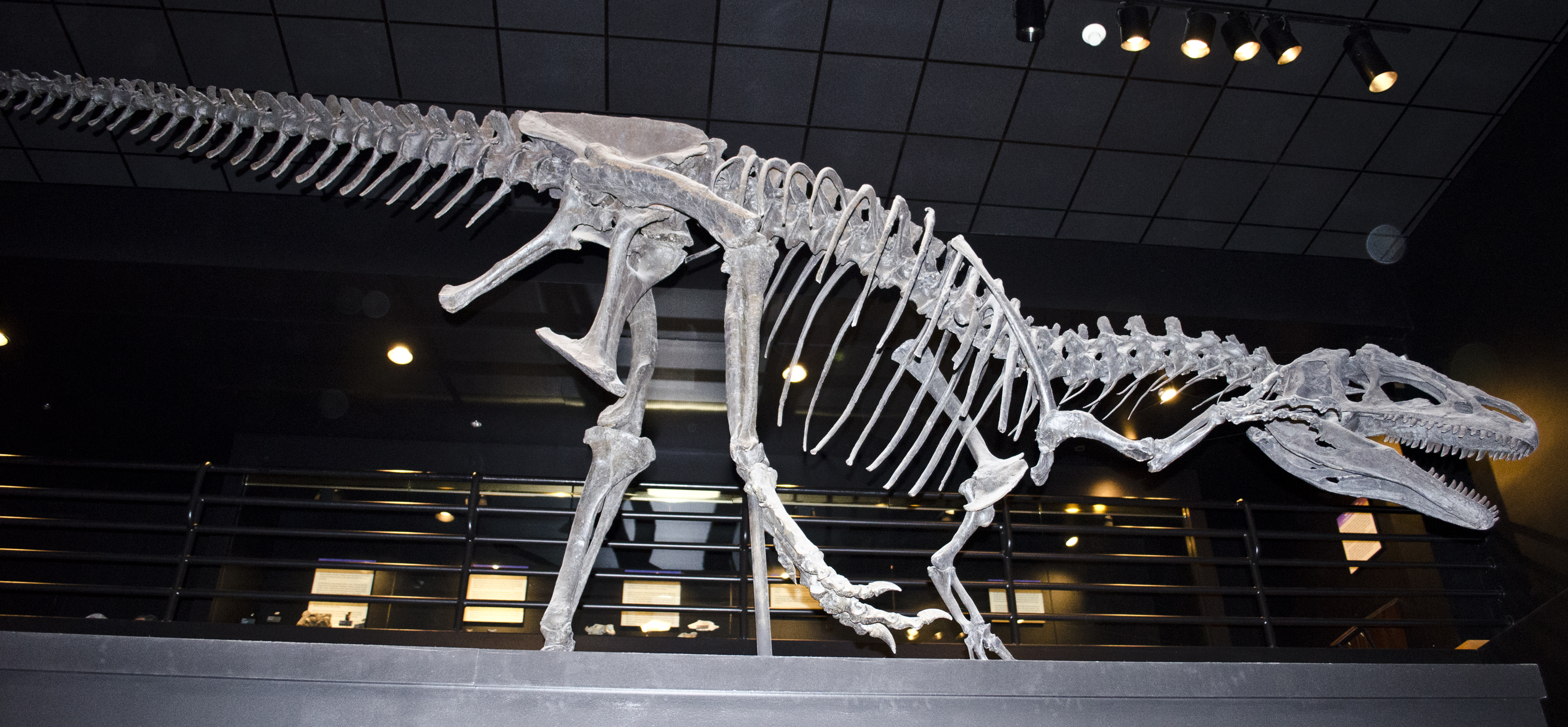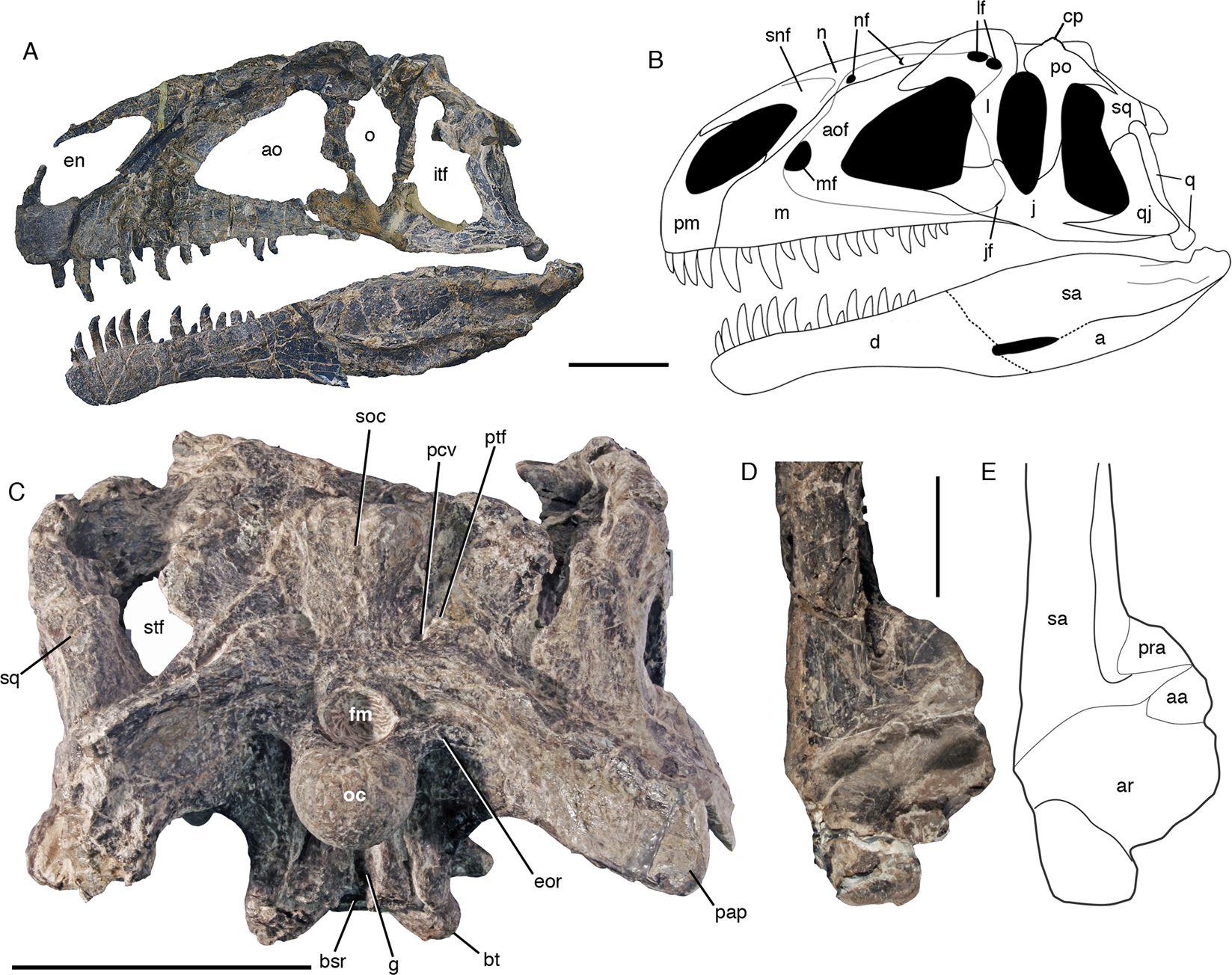|
Allosaurid
Allosauridae is an extinct family of medium to large bipedal, carnivorous allosauroid theropod dinosaurs from the Late Jurassic. Allosauridae is a fairly old taxonomic group, having been first named by the American paleontologist Othniel Charles Marsh in 1878. Description Allosaurids have a general anatomy typical of other neotheropod dinosaurs, contributing to the difficulty in defining the family's membership. A typical 8m specimen of ''Allosaurus fragilis'' had a skull of about 0.85m. The premaxilla has five teeth and the maxilla usually around 16. The dentary also typically has 16 teeth. All teeth are serrated and continuously replaced throughout the life of the animal. Allosaurid skulls are characterized by two sets of crests formed by the nasal and lacrimal bones respectively. These crests would have been covered by keratin sheathes.Madsen, James H., Jr. (1993) 976 ''Allosaurus fragilis: A Revised Osteology''. Utah Geological Survey Bulletin 109 (2nd ed.). Salt Lake City ... [...More Info...] [...Related Items...] OR: [Wikipedia] [Google] [Baidu] |
Allosaurus Fragilis
''Allosaurus'' ( ) is an extinct genus of theropoda, theropod dinosaur that lived 155 to 145 million years ago during the Late Jurassic Geologic time scale, period (Kimmeridgian to late Tithonian Geologic time scale, ages). The first fossil remains that could definitively be ascribed to this genus were described in 1877 in paleontology, 1877 by Othniel Charles Marsh, Othniel C. Marsh. The name "''Allosaurus''" means "different lizard", alluding to its lightweight , which Marsh believed were unique. The genus has a very complicated Taxonomy (biology), taxonomy and includes at least three valid species, the best known of which is ''A. fragilis''. The bulk of ''Allosaurus'' remains come from North America's Morrison Formation, with material also known from the Alcobaça Formation and Lourinhã Formation in Portugal. It was known for over half of the 20th century as ''Antrodemus'', but a study of the abundant remains from the Cleveland-Lloyd Dinosaur Quarry returned the name "''Al ... [...More Info...] [...Related Items...] OR: [Wikipedia] [Google] [Baidu] |
Allosaurus
''Allosaurus'' ( ) is an extinct genus of theropod dinosaur that lived 155 to 145 million years ago during the Late Jurassic period ( Kimmeridgian to late Tithonian ages). The first fossil remains that could definitively be ascribed to this genus were described in 1877 by Othniel C. Marsh. The name "''Allosaurus''" means "different lizard", alluding to its lightweight , which Marsh believed were unique. The genus has a very complicated taxonomy and includes at least three valid species, the best known of which is ''A. fragilis''. The bulk of ''Allosaurus'' remains come from North America's Morrison Formation, with material also known from the Alcobaça Formation and Lourinhã Formation in Portugal. It was known for over half of the 20th century as '' Antrodemus'', but a study of the abundant remains from the Cleveland-Lloyd Dinosaur Quarry returned the name "''Allosaurus''" to prominence. As one of the first well-known theropod dinosaurs, it has long attracted attention ... [...More Info...] [...Related Items...] OR: [Wikipedia] [Google] [Baidu] |
Carnosauria
Carnosauria is an extinct group of carnivorous theropod dinosaurs that lived during the Jurassic and Cretaceous periods. While Carnosauria was historically considered largely synonymous with Allosauroidea, some recent studies have revived Carnosauria as clade including both Allosauroidea and Megalosauroidea (which is sometimes recovered as paraphyletic with respect to Allosauroidea), and thus including the majority of non- coelurosaurian members of theropod clade Tetanurae. Other researchers have found Allosauroidea and Megalosauroidea to be unrelated groups.Cau A. (2024)A Unified Framework for Predatory Dinosaur Macroevolution Bollettino della Società Paleontologica Italiana, 63(1): 1-19. Distinctive characteristics of carnosaurs include large eye sockets, a long narrow skull and modifications of the legs and pelvis such as the thigh (femur) being longer than the shin ( tibia). Carnosaurs first appeared in the Middle Jurassic around , and the last definitive carnosau ... [...More Info...] [...Related Items...] OR: [Wikipedia] [Google] [Baidu] |
Allosauroidea
Carnosauria is an extinct group of carnivorous theropod dinosaurs that lived during the Jurassic and Cretaceous periods. While Carnosauria was historically considered largely synonymous with Allosauroidea, some recent studies have revived Carnosauria as clade including both Allosauroidea and Megalosauroidea (which is sometimes recovered as paraphyletic with respect to Allosauroidea), and thus including the majority of non- coelurosaurian members of theropod clade Tetanurae. Other researchers have found Allosauroidea and Megalosauroidea to be unrelated groups.Cau A. (2024)A Unified Framework for Predatory Dinosaur Macroevolution Bollettino della Società Paleontologica Italiana, 63(1): 1-19. Distinctive characteristics of carnosaurs include large eye sockets, a long narrow skull and modifications of the legs and pelvis such as the thigh (femur) being longer than the shin (tibia). Carnosaurs first appeared in the Middle Jurassic around , and the last definitive carnosaur famil ... [...More Info...] [...Related Items...] OR: [Wikipedia] [Google] [Baidu] |
Antrodemus
''Antrodemus'' ("chamber bodied") is a dubious genus of theropod dinosaur from the Upper Jurassic, probably the Morrison Formation, of Middle Park, Colorado. It contains one species, ''Antrodemus valens'', first described and named as a species of '' Poekilopleuron'' by Joseph Leidy in 1870. Discovery and species The first described fossil specimen was a bone obtained secondhand by Ferdinand Vandeveer Hayden in 1869 (original discoverer unknown). It came from Middle Park, near Granby, Colorado, probably from Morrison Formation rocks. Hayden reported that several similar fossils had been identified as petrified horse hooves. Hayden sent his specimen to Joseph Leidy, who identified it as half of a tail vertebra, and tentatively assigned it to the European dinosaur genus '' Poekilopleuron'' as ''Poicilopleuron'' ic''valens'', based on the shared presence of a large medullary cavity. He identified the presence of trabeculae in ''P''. ''valens'' as a distinguishing character from ... [...More Info...] [...Related Items...] OR: [Wikipedia] [Google] [Baidu] |
Asfaltovenator
''Asfaltovenator'' (meaning "Cañadón Asfalto Formation hunter" after the fossil formation in which its fossils were found) is a genus of possibly allosauroid dinosaur from the Lower Jurassic (Middle Toarcian) Cañadón Asfalto Formation of Chubut Province, Argentina. The type species, type and only species is ''Asfaltovenator vialidadi''. Discovery In 2002, technician Leandro Canesa discovered a theropod skeleton roughly a mile north of Cerro Condor. Excavations started in 2005, and the fossil was removed in its entirety in 2007. It was then prepared by Mariano Caffa, a process that took five years due to the extreme hardness of the stone matrix. Between 2013 and 2015, it was compared with the specimens of related theropods. In 2019, the type species ''Asfaltovenator vialidadi'' was named and described by Oliver Walter Mischa Rauhut and Diego Pol. The generic name combines a reference to the Cañadón Asfalto Formation with the Latin word ''venator'', meaning "hunter". The sp ... [...More Info...] [...Related Items...] OR: [Wikipedia] [Google] [Baidu] |
Piatnitzkysauridae
Piatnitzkysauridae is an extinct family of megalosauroid or basal allosauroid dinosaurs. It only consists of three to four known dinosaur genera: '' Condorraptor'', '' Marshosaurus'', '' Piatnitzkysaurus and'' possibly '' Xuanhanosaurus.'' The most complete and well-known member of this family is ''Piatnitzkysaurus'', which also gives the family its name. Description So far, all known piatnitzkysaurids have only been found in Jurassic deposits of the western hemisphere/New world (however, if ''Xuanhanosaurus'' is included, this may expand their range). ''Piatnitzkysaurus'' and ''Condorraptor'' hail from the Cañadón Asfalto Formation of Argentina, which has been dated from the Toarcian epoch of the Early Jurassic to the Bathonian epoch of the Middle Jurassic (approximately 179 to 168 million years ago). ''Marshosaurus'' was found in the Morrison Formation of the United States, which was dated to the Kimmeridgian epoch of the Late Jurassic. Piatnitzkysaurids were among the fi ... [...More Info...] [...Related Items...] OR: [Wikipedia] [Google] [Baidu] |
Dinosaurs
Dinosaurs are a diverse group of reptiles of the clade Dinosauria. They first appeared during the Triassic Geological period, period, between 243 and 233.23 million years ago (mya), although the exact origin and timing of the #Evolutionary history, evolution of dinosaurs is a subject of active research. They became the dominant terrestrial vertebrates after the Triassic–Jurassic extinction event 201.3 mya and their dominance continued throughout the Jurassic and Cretaceous periods. The fossil record shows that birds are feathered dinosaurs, Evolution of birds, having evolved from earlier Theropoda, theropods during the Late Jurassic epoch, and are the only dinosaur lineage known to have survived the Cretaceous–Paleogene extinction event approximately 66 mya. Dinosaurs can therefore be divided into avian dinosaurs—birds—and the extinct non-avian dinosaurs, which are all dinosaurs other than birds. Dinosaurs are varied from taxonomy (biology), taxonomic, ... [...More Info...] [...Related Items...] OR: [Wikipedia] [Google] [Baidu] |
Theropods
Theropoda (; from ancient Greek , (''therion'') "wild beast"; , (''pous, podos'') "foot"">wiktionary:ποδός"> (''pous, podos'') "foot" is one of the three major groups (clades) of dinosaurs, alongside Ornithischia and Sauropodomorpha. Theropods, both extant and extinct, are characterized by hollow bones and three toes and claws on each limb. They are generally classed as a group of saurischian dinosaurs, placing them closer to sauropodomorphs than to ornithischians. They were ancestrally carnivorous, although a number of theropod groups evolved to become herbivores and omnivores. Members of the subgroup Coelurosauria and possibly some other or all theropods were covered in feathers. In the Jurassic, birds evolved from small specialized coelurosaurian theropods, and are currently represented by about 11,000 living species, making theropods the only group of dinosaurs alive today. Theropods first appeared during the Carnian age of the late Triassic period ... [...More Info...] [...Related Items...] OR: [Wikipedia] [Google] [Baidu] |
Metriacanthosauridae
Metriacanthosauridae (Greek for "moderately-spined lizards") is an extinct family of allosauroid theropod dinosaurs that lived in Europe and Asia from the Middle Jurassic to the Early Cretaceous. The family is split into two subgroups: Metriacanthosaurinae, which includes dinosaurs closely related to '' Metriacanthosaurus'', and another group composed of the close relatives of '' Yangchuanosaurus''. Metriacanthosaurids are considered carnosaurs, belonging to the Allosauroidea superfamily. The group includes species of large range in body size. Of their physical traits, most notable are their neural spines.Bailey, Jack Bowman. "Neural Spine Elongation in Dinosaurs: Sailbacks or Buffalo-Backs?" Journal of Paleontology, vol. 71, no. 06, 1997, pp. 1124–1146., doi:10.1017/s0022336000036076. The records of the group are mostly confined to Asia, though ''Metriacanthosaurus'' is known from Europe. Metriacanthosauridae is used as a senior synonym of Sinraptoridae. Diagnostic traits ... [...More Info...] [...Related Items...] OR: [Wikipedia] [Google] [Baidu] |
Neotheropoda
Theropoda (; from ancient Greek , (''therion'') "wild beast"; , (''pous, podos'') "foot"">wiktionary:ποδός"> (''pous, podos'') "foot" is one of the three major groups (clades) of dinosaurs, alongside Ornithischia and Sauropodomorpha. Theropods, both extant and extinct, are characterized by hollow bones and three toes and claws on each limb. They are generally classed as a group of saurischian dinosaurs, placing them closer to sauropodomorphs than to ornithischians. They were ancestrally carnivorous, although a number of theropod groups evolved to become herbivores and omnivores. Members of the subgroup Coelurosauria and possibly some other or all theropods were covered in feathers. In the Jurassic, birds evolved from small specialized coelurosaurian theropods, and are currently represented by about 11,000 living species, making theropods the only group of dinosaurs alive today. Theropods first appeared during the Carnian age of the late Triassic period 2 ... [...More Info...] [...Related Items...] OR: [Wikipedia] [Google] [Baidu] |









